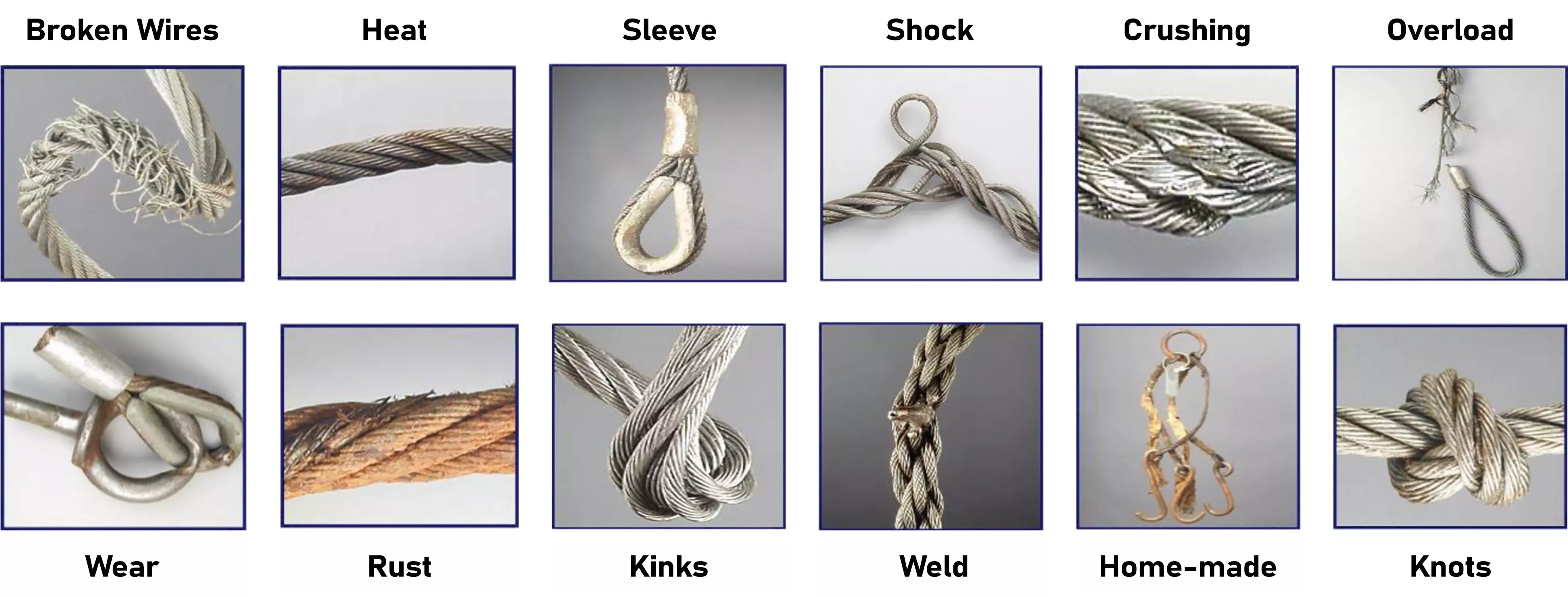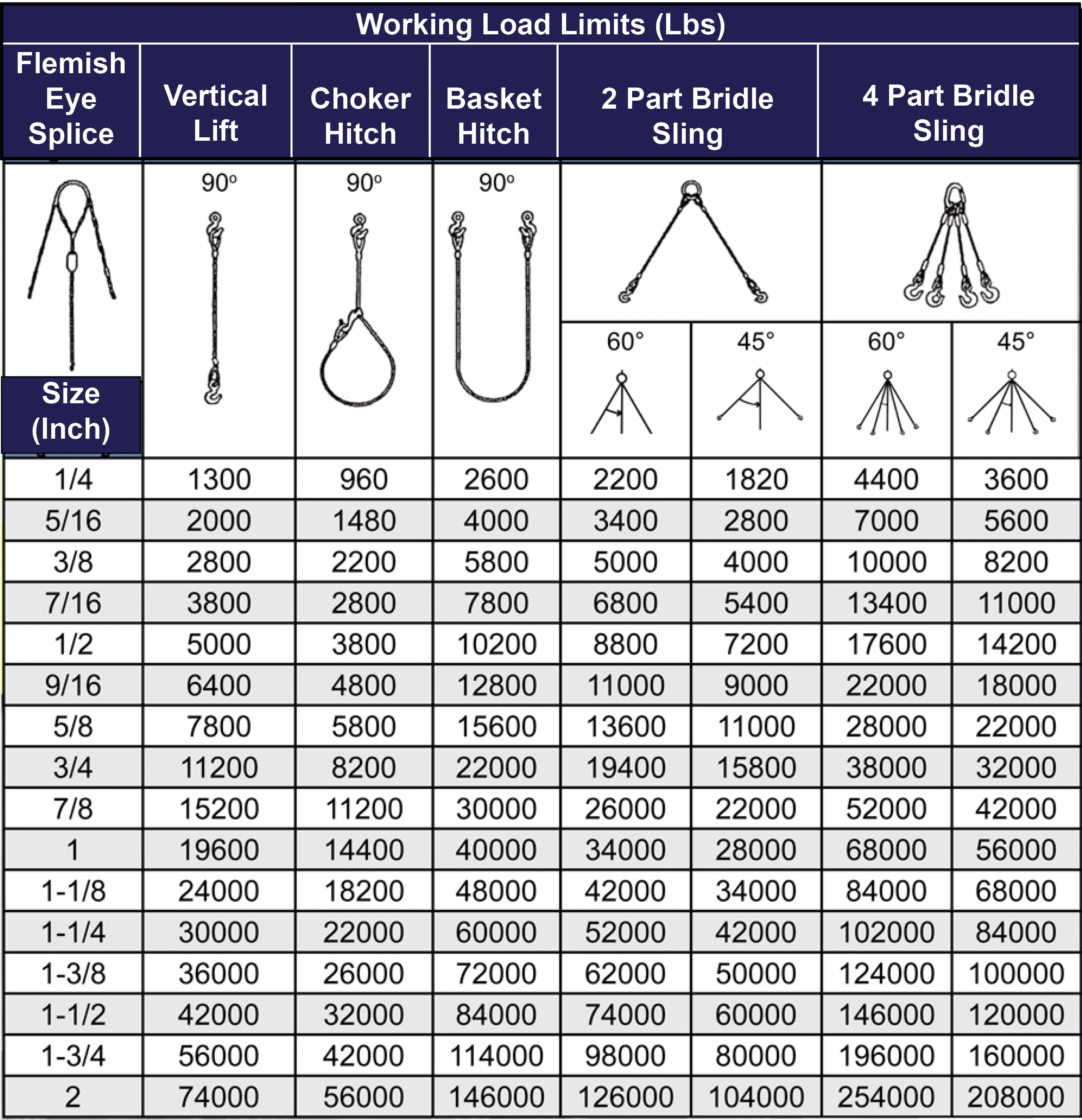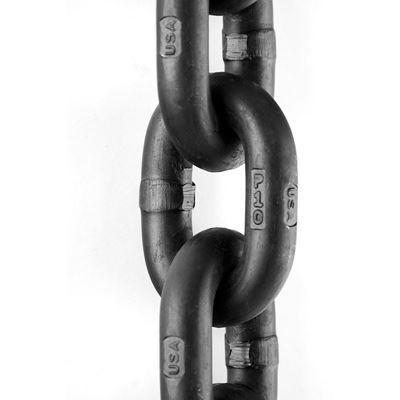This page contains; Advantages of using wire rope slings | Disadvantages of using wire rope slings | Criteria for wire rope to fail inspection | Applications for using wire rope to perform a lift | Working load limits of wire rope in different hitch types | Advantages of using chain slings | Disadvantages of using chain slings | Criteria for chain slings to fail inspection | How chain grade is calculated | Applications for using chain slings to perform a lift | Working load limits of chain slings in different hitch types | Choosing the right hitch type for your application | How to calculate a slings D/d ratio
Wire Rope Slings vs Chain Slings - Rigging 101
When planning a lift or position, it is important to understand that every application and job site has a unique set of variables that must be considered. Taking the time to carefully evaluate these factors will help you make an informed decision about how to perform the lift, and what sling-type best suits the job.
The focus of this article will discuss the Advantages and Disadvantages of Wire Rope and Chain Slings to help determine what the best sling type is for your lift or position based on your lift plan.
Wire Rope Slings
Wire Rope consists of multiple steel wires that form individual strands wrapped around a steel core. This construction provides strength, flexibility, and the ability to handle bending stresses. There are many build variations of Wire Rope, each with strengths and weaknesses, allowing them to be versatile and used in various applications.
Advantages of using wire rope slings
- Lowest ‘cost per ton’ of lift
- High strength and flexibility in smaller diameter design
- Fits snug in a choker hitch, keeping the load secure
- If the sling is damaged the hardware can be reused assuming it is not also affected (master links, etc.)
Disadvantages of using wire rope slings
- Lower strength to weight ratio when compared to Chain Slings
- The nature of the construction makes it difficult to inspect, especially in and around the core
- Susceptible to internal and external corrosion
- Misuse and abuse can lead to kinking, crushing, or broken wires
- The shape and weight of the load may require you to use additional padding on corners to prevent damage to the sling
- Cannot be used above 400°F or below -40°F
- Cannot be repaired; must be removed from service if an inspection is failed
Criteria for Wire Rope to Fail Inspection
Broken Wires are typically quite obvious, but they can sometimes be subtle. One way to look for broken wires is to run your hand up and down the sling (with proper puncture/cut gloves) to see if you notice any abnormalities. You can also bend the sling throughout, watching for frayed wires sticking out.
Heat Damage occurs when wire rope slings are exposed to temperatures exceeding 400°F. Exposure to these temperatures will affect the steel core’s strength, causing it to become unreliable when under stress from heavier loads. Elevated temperatures also dry out the lubricant between the wire strands and core, affecting the wire rope's flexibility and making it more susceptible to corrosion and premature breakage over time.
Sleeve Damage is the result of having the load sit on the sleeve of your sling. This is common in lifts performed with slings that are too short.
Shock Damage is caused by the sudden release in tension causing the wires around the core to unravel.
Crushing can occur when an overweight load sits on the sling, essentially pinching and abrading the strands on the surface and breaking wires.
Wear is caused by the long-term use of your slings and can be identified as a combination of rust, damaged wires/fittings, or other criteria that make the sling unfit for use in the field.
Overloading occurs when a load exceeds the Working Load Limit (WLL) of the sling.
Rust in minimal amounts will not impact the strength of your sling. However, it is important to remember that rust spreads quickly and may not always be visible due to the construction of wire rope slings.
Kinks occur when wire rope is twisted around itself causing the outer wires to unravel. Note that it is common for wire rope slings to have some bends that straighten out under normal load conditions, and these do not affect the strength or integrity of the sling.
Welding Splatter prevents the individual strands from moving and flexing with the movement of the load causing weak points which can ultimately result in failure of the sling.
Home-made rigging solutions that are not ASME approved should not be used to perform a lift or position. When in doubt, always consult an expert before developing a rigging solution.
Knots impact the tensile strength of wire rope slings as it creates tension at points where the rope overlaps, causing weak points destined for failure.

Popular Industry Applications for Using Wire Rope
- Construction
- Automotive
- Oil & Gas
- Manufacturing
- Steal Mills
- Forging Facilities
Wire Rope Working Load Limit Cheat Sheet

Chain Slings
When toughness is what you’re looking for, look no further than Alloy Chain slings. Known for its durability and dependability in rugged environments, these slings are absolute workhorses when performing overhead lifts and positions.
While Chain Slings are known for their durability, it is important to note that MacMor Industries primarily recommends Grade 100 Alloy Steel Chain for overhead lifting.
Advantages of Using Chain Slings
- 5-1 design factor means its breaking strength is 5x higher than the rated WLL (although you should never exceed the recommended working load)
- Ideal for heavy-duty loads; very durable
- Flexible
- Perfect for high-temperature applications
- Repairable; chain and fittings can easily be swapped, inspected, proof tested and recertified
- Versatile; multi-leg assemblies can be built with different components and lengths to balance irregular loads
- Resistant to corrosion, chemicals, and UV exposure
- During pre-use inspection, over-worked chain will show 15-20% elongation as an indicator that it must be removed from service
Disadvantages of Using Chain Slings
- Expensive
- Time-consuming inspection. This may come as a surprise considering wire rope is a more complex product than chain, however a typical wire rope inspection is more “touch and feel” based to quickly identify issues, while chain assemblies require a more careful visual inspection of the links/fittings and labels.
- Very heavy; the higher the WLL the heavier the chain
- Can easily damage sensitive materials or finished parts
Criteria for Chain Slings to Fail Inspection
Wear can occur when slings are overused. Over the course of its life, links of the chain rub against the ground, loads being lifted, and other surfaces that gradually weaken the chain. If wear exceeds 15% of the normal diameter of the link it should be removed from service. This damage includes twisted links, cuts, nicks, gouges, and stretched links.
Bent Links typically result from lifting irregular loads or blunt force damage. A length of chain is only as strong as its weakest link, so it is important to take the proper steps in repairing or disposing of damaged slings.
Hinging occurs when warped links prevent other links and/or end fittings from moving properly, which can have an impact on the chain sling’s overall flexibility.
Stretch is a visible sign that a chain has been over-worked; up to 5% stretch is acceptable but anything more than that is a visual indicator that the sling should be removed from service.
Cuts / Gouges are often the result of a chain striking an object while under tensile stress.
Weld Damage refers to welding splatter on the chain; although seemingly harmless since alloy chain is heat treated, splatter is considered a form of heat damage since it is extremely hot molten metal. When it hits the chain, it affects the heat treatment properties of the link(s), affecting its overall structural integrity.
Twisted Links occur when loads have a low D/d ratio.
Illegible Tags means that some or all the details on the sling tag are no longer visible or able to be identified properly. Equipment being used for overhead lifting should always be tagged with specs to ensure the right sling is being used based on the lift requirements. There should never be any guessing involved when selecting a sling.
Makeshift rigging solutions that are not ASME approved should not be used to perform a lift or position. When in doubt, always consult an expert before developing a rigging solution.
Damaged links and fittings must be removed and replaced immediately as they threaten the integrity of the whole sling. Remember, assemblies are only as strong as their weakest component.
DIY Repairs include any attempts to weld or fix links of chain or fittings. Unapproved repairs greatly impact the reliability and strength of your chain sling which is an enormous safety hazard.

How is chain grade measured?
-
- The grade of a chain is determined by the equation: G=N/mm2
G=grade, N=newtons and mm^2 = area between 2 cross-sections of chain
-
- The chain is pulled in a testbed to determine the breaking force required
-
- Most testing beds operated in lbs. so we must convert to newtons which is
N = (lbs to break) / (.224805)
-
- Then, the cross section between 2 links of chain is measured to calculate mm^2
Ex: ¼” Chain = 0.25in = 6.35mm so 6.35x6.35 = 40.3225mm^2
-
- The last step is to fill in the equation with the values to calculate the grade of the chain
Note: It is important to remember that grade of chain is often represented as 1/10 of the grade
meaning that grade 80 represents 800
Chain Sling Working Load Limit Cheat Sheet

Popular Industry Applications for Using Chain Slings
- High-temperature work environments
- Hazardous work environments
- Applications involving chemical or UV exposure
Choosing the Best Hitch for My Lift
Vertical
- Most basic lift method
- Utilizes the whole WLL of the sling
- When performing a vertical lift with a single sling, a tag-line is highly recommended to help control the load and prevent it from twisting or swaying back and forth. Typically made of synthetic material, taglines are secured to the load and managed by riggers. For more detailed information on taglines, check out this article
Choker
- Offers better control as the sling sits snug around the load
- Greatly reduces the working load limit of a sling as it creates a stress point at the choke
- The angle of chock impacts WLL
Basket
- Doubles the WLL of a sling when used at 90° with a large D/d ratio (25:1)
- When a sling is attached at an angle less than 90°, the WLL is reduced
- Should not be used with loads that do not easily balance (i.e. irregular shapes)
- Performing a double wrap basket hitch allows for greater load control
D/d Ratio
- D/d is the ratio between the diameter of the load divided by the body diameter of the sling. Having a lower ratio means the sling will have to wrap more aggressively around the load, placing significant tension on a small part of the sling

Multi-Leg Bridle Assembly
- Multiple lengths of wire rope or chain called ‘legs’ are attached to a master link, and each leg goes to an attachment point
- It is possible for each leg to have its own unique length to ensure a load is properly balanced
- It is important to note that much like basket hitches, the angle of a Bridle assembly will affect the WLL as the angle decreases

Summary
Whether a wire rope or chain sling is the best solution for your lift will depend on a complete understanding of the application, the environment where the sling will be in use, and how the sling will be used to support and lift the load.
MacMor Industries is your one-stop shop for rigging products, training, proof testing, inspections/repairs, and certification. If you need help planning out a rigging solution, please do not hesitate to contact us. one of our Rigging Specialists or Sales Representatives would be more than happy to work with you in building an assembly that meets your needs.
Like the Blog and Video? Please consider sharing it with your friends and your team.






